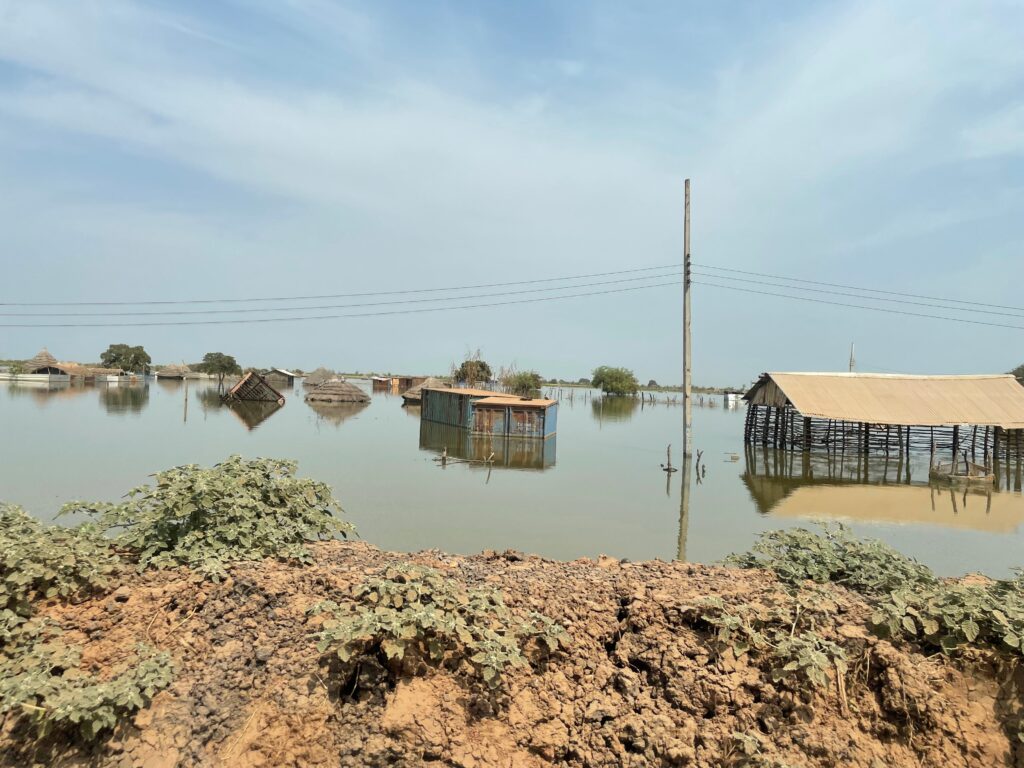Share
South Sudan has experienced extreme flooding over the past three years, with 835,000 people affected by flooding in 2021 alone. Below, we highlight the exploratory work the Centre has done related to flood forecasting in South Sudan and bring to the fore the high risk of extreme flooding in 2022 based on this analysis.
In February 2022, I traveled to South Sudan along with OCHA colleagues from the Central Emergency Response Fund (CERF) and the Humanitarian Financing Strategy and Analysis Unit. Our goal was to explore the possibility of establishing an anticipatory action pilot focused on the country’s most severely flood affected areas. My specific role was to explore the available data and forecasts that could be used to select areas of intervention and build a monitoring framework to trigger anticipatory action. During the mission, we visited Juba, Bentiu and Malakal and used local data sources and expert input to contextualize and supplement our initial analysis based on Floodscan flood extents data, food security projections and flood impact estimates.

The flood dynamics in South Sudan, particularly in and around the Sudd wetlands, are extremely complex. Abnormally high flooding, increasingly prevalent in recent years, has been traced to a variety of factors such as high levels of rainfall in South Sudan itself, rainfall and water levels upstream in neighboring countries and a lack of river system management. However, limited and noisy data has failed to produce clear relationships between severe flooding and specific factors such as rainfall.

After in-depth analysis and consultation with the OCHA office and partners, we initially explored the methods used to predict flooding for the anticipatory action pilots in Nepal and Bangladesh, which relied on global and national flood forecasts. However, the predictive performance of global forecasts was much poorer in South Sudan and national forecasts were unavailable. Given these challenges with flood forecasting, a standard anticipatory action approach was not technically feasible.
Despite this relative unpredictability of flooding in normal years, our analysis highlighted a significant risk of catastrophic flooding in 2022. Typically, flooding fluctuates throughout the Sudd wetlands, with peaks seen during the wet season and flood waters receding up until April and May each year. However, during the 2021 dry season following the 2020 flooding, the high levels of flooding failed to sufficiently recede.
This lack of receding flood waters provided a high baseline level of flood waters that additional flooding in the 2021 rainy season built upon. This resulted in record flooding in 2021 with peaks twice the level as that seen in any previous years on record.

As of the end of April 2022, flood extents are still extremely high, and well above levels in 2021 at this point in the season. Although the floods have been receding in the past months, it would require unprecedented drainage of the river system and surrounding flood waters to reach normal levels before levels start to rise again in May or June. The current standing waters mean that any additional rainfall or inflows during the rainy season could result in flooding at or beyond the levels seen in 2021, when rainfall was below average across the region.
Much of the flooding since 2020 has reportedly been due to high levels of water upstream, such as in Lake Albert in Uganda. While these water levels have been receding since the beginning of 2022, they still remain at historical highs, and there will still likely be significant throughflow into South Sudan throughout the rainy season in 2022.

8.9 million people are in need across the country with conflict, displacement and multiple years of flooding stopping agricultural production, negatively impacting livelihoods and driving up food insecurity. Sustainable solutions to the issue of flooding in South Sudan are underway, with the International Organization for Migration and the Netherlands working on medium to long-term flood and climate resilience.
Overall, our mission findings show that there is a high risk of catastrophic flooding impacting vulnerable people in South Sudan in the second half of 2022, particularly in recently flooded areas surrounding the Sudd in Jonglei and Unity states. With 835,000 people already impacted in 2021, we anticipate that as many, or more, will be affected by flooding this year.
Building on this analysis and other mission findings highlighting the urgency for action, CERF and the South Sudan Humanitarian Fund (SSHF) have released US$19 million ahead of projected flooding to prepare and protect people in the Bentiu camp for internally displaced people and surrounding areas in Unity State, which are among the areas most exposed to severe flooding.
The SSHF has allocated $4 million to enable NGOs and UN agencies to reinforce dikes around vital access roads, community centers, and the airstrip whereas $15 million from CERF will support people to protect their homes as well as key infrastructure such as latrines and water wells from flood water, and in so doing will aim to avert a public health emergency.
The Centre will continue to monitor the flooding situation and support OCHA’s response to flood affected populations.